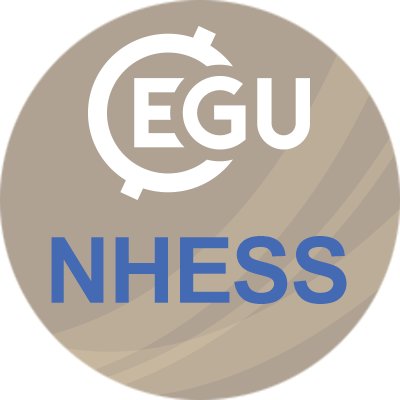
Natural Hazards and Earth System Sciences (NHESS)
@EGU_NHESS
Followers
3K
Following
214
Media
130
Statuses
5K
This account is no longer maintained. Visit our website at: https://t.co/dREq8jqzU0
Joined July 2014
Discussion open for comments on @EgUsphere: Modeling wave-vegetation interactions: the impact of seagrass flexibility and seasonal variability
1
0
0
Discussion open for comments on @EgUsphere: Review Article: Analysis of sediment disaster risk assessment surveys in Brazil: A critical review and recommendations
0
0
0
Discussion open for comments on @EgUsphere: Groundwater recharge in Brandenburg is declining – but why?
0
0
0
Discussion open for comments on @EgUsphere: Computing Extreme Storm Surges in Europe Using Neural Networks
egusphere.copernicus.org
Abstract. Because of the computational costs of computing storm surges with hydrodynamic models, projections of changes in extreme storm surges are often based on small ensembles of climate model...
0
0
0
Discussion open for comments on @EgUsphere: Analysis of Long-Term Changes in Extreme Waves in the Northwest Pacific Over the Past 60 Years
egusphere.copernicus.org
Abstract. This study analyses wave height trends in the Northwest Pacific over the past 60 years and estimates design wave heights across various return periods to assess the resilience of marine and...
0
0
0
New research article: Unraveling landslide failure mechanisms with seismic signal analysis for enhanced pre-survey understanding
nhess.copernicus.org
Abstract. Seismic signals, with their remote and continuous monitoring advantages, have been instrumental in unveiling various landslide characteristics and have been widely applied in the past...
0
0
1
Discussion open for comments on @EgUsphere: Anatomy of a Flash Flood in a Hyperarid Environment: From Atmospheric Masses to Sediment Dispersal in the Sea
0
0
0
Discussion open for comments: Indirect assimilation of radar reflectivity data with an adaptive hydrometer retrieval scheme for the short-term severe weather forecasts
nhess.copernicus.org
Abstract. Different hydrometeor retrieval schemes are explored based on the Weather Research and Forecasting (WRF) model in the indirect assimilation of radar reflectivity for two real cases occurred...
0
0
0
Discussion open for comments: Catastrophic beach erosion induced by littoral drift on nearby beach after Samcheok LNG's massive coastal reclamation project
nhess.copernicus.org
Abstract. Large-scale construction projects, such as port construction and reclamation endeavors, can alter inshore wave dynamics, leading to severe coastal erosion. In South Korea, recent large-sc...
0
0
0
Discussion open for comments on @EgUsphere: Regional-scale groundwater analysis with dimensionality reduction
egusphere.copernicus.org
Abstract. Given the importance of groundwater for freshwater provision and groundwater-dependent ecosystems, understanding climate effects on groundwater changes at a regional scale is essential. In...
0
0
2
New research article: Assimilation of temperature and relative humidity observations from personal weather stations in AROME-France
nhess.copernicus.org
Abstract. Personal weather station (PWS) networks owned by citizens now provide near-surface observations at a spatial density unattainable with standard weather stations (SWSs) deployed by national...
0
0
1
Discussion open for comments: Cities near volcanoes: Which cities are most exposed to volcanic hazards?
nhess.copernicus.org
Abstract. Cities near volcanoes expose dense concentrations of people, buildings, and infrastructure to volcanic hazards. Identifying cities globally that are exposed to volcanic hazards helps guide...
0
0
0
Discussion open for comments on @EgUsphere: Identifying controlling climate factors conducive to water and nitrogen export from agricultural watershed during snowmelt runoff period by using the SWAT model
egusphere.copernicus.org
Abstract. Temperature and precipitation variations during the freezing-thawing period affect snowmelt and accompanying nitrogen export in a complex manner. These influences can be long-lasting,...
0
0
0
Discussion open for comments on @EgUsphere: Brief communication: Hydrological and hydraulic investigation of the extreme September 2024 flood on the Lamone River in Emilia-Romagna, Italy
0
0
0
Discussion open for comments on @EgUsphere: Identification of nighttime urban flood inundation extent using deep learning
0
1
0
New research article: Large-scale flood risk assessment in data-scarce areas: an application to Central Asia
nhess.copernicus.org
Abstract. The countries of Kazakhstan, Kyrgyz Republic, Tajikistan, Turkmenistan, and Uzbekistan in Central Asia are highly prone to natural hazards, particularly floods, earthquakes, and landslides....
0
1
3
Discussion open for comments: Dynamic analysis of drought propagation in the context of climate change and watershed characterization: a quantitative study based on GAMLSS and Copula models
0
0
0
New #EGUhighlights: Modelling current and future forest fire susceptibility in north-eastern Germany
nhess.copernicus.org
Abstract. Preventing and fighting forest fires has been a challenge worldwide in recent decades. Forest fires alter forest structure and composition; threaten people's livelihoods; and lead to...
1
0
1
New #EGUhighlights: A methodology to compile multi-hazard interrelationships in a data-scarce setting: an application to the Kathmandu Valley, Nepal
nhess.copernicus.org
Abstract. This paper introduces a multifaceted methodology to identify and compile single natural hazards and multi-hazard interrelationships within the context of data-scarce urban settings,...
0
0
1
Discussion open for comments on @EgUsphere: Review Article: Rainfall‑Induced Landslide Prediction Models, Part I: Empirical-Statistical and Physically Based Causative Thresholds
egusphere.copernicus.org
Abstract. Landslides rank among the most devastating hazards, leading to loss of life and destruction of infrastructure, with rainfall being a primary triggering factor. Global climate change has...
0
0
3









